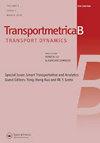不同交通状态下高速公路追尾事故风险演化机制分析
IF 3.4
2区 工程技术
Q2 TRANSPORTATION
引用次数: 3
摘要
本文章由计算机程序翻译,如有差异,请以英文原文为准。
Expressway rear-end crash risk evolution mechanism analysis under different traffic states
The proportion of rear-end crashes is the highest for expressways. An effective ways to reduce the rear-end crash risk is Active Traffic Management (ATM), and knowing the mechanism of how contributing factors affect crash risk in space and time is the foundation of ATM. However, the existing studies are mainly based on highly aggregated traffic data. It is hard to capture the evolution mechanisms of crash risk. Meanwhile, crash risk mechanisms might be heterogeneous in smooth and congestion states. This study explored the crash mechanisms in different traffic states with high-resolution trajectory data. First, an ordered clustering method is used to divide a four km expressway section into several segments as the spatial unit. Second, the spatial–temporal ranges are decided by the spatial–temporal correlations analyses between crash risk and potential contributing factors. Thirdly, three types of time-series models are established to quantitatively obtain the impacts of contributing factors on the crash risks. The results showed that crash risk is mainly decided by the upstream contributing factors under smooth states, and determined by the downstream factors under congestion conditions.
求助全文
通过发布文献求助,成功后即可免费获取论文全文。
去求助
来源期刊

Transportmetrica B-Transport Dynamics
TRANSPORTATION SCIENCE & TECHNOLOGY-
CiteScore
5.00
自引率
21.40%
发文量
53
期刊介绍:
Transportmetrica B is an international journal that aims to bring together contributions of advanced research in understanding and practical experience in handling the dynamic aspects of transport systems and behavior, and hence the sub-title is set as “Transport Dynamics”.
Transport dynamics can be considered from various scales and scopes ranging from dynamics in traffic flow, travel behavior (e.g. learning process), logistics, transport policy, to traffic control. Thus, the journal welcomes research papers that address transport dynamics from a broad perspective, ranging from theoretical studies to empirical analysis of transport systems or behavior based on actual data.
The scope of Transportmetrica B includes, but is not limited to, the following: dynamic traffic assignment, dynamic transit assignment, dynamic activity-based modeling, applications of system dynamics in transport planning, logistics planning and optimization, traffic flow analysis, dynamic programming in transport modeling and optimization, traffic control, land-use and transport dynamics, day-to-day learning process (model and behavioral studies), time-series analysis of transport data and demand, traffic emission modeling, time-dependent transport policy analysis, transportation network reliability and vulnerability, simulation of traffic system and travel behavior, longitudinal analysis of traveler behavior, etc.
 求助内容:
求助内容: 应助结果提醒方式:
应助结果提醒方式:


